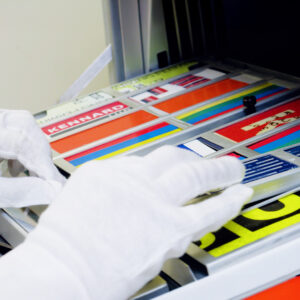
Experiencing difficulties choosing between the different printing methods for your project? Do you want to understand the difference between Screen Printing and Digital printing? When it comes to printing techniques, each produces results that are unique and cannot be easily replicated by another technique, hence it is ideal to understand the different printing technique and the results it produces.
For over 40 years Signprint has been using both these printing techniques to produce various types of signage and working with these printing techniques has helped us understand their strength and weakness. In this article, we are going to provide an honest comparison between Screen and Digital printing so you can decide which technique is ideal for you and your business.
This is an old printing technique that uses a mesh frame, ink, and stencils to create a print. The mesh frame is coated in an emulsion which is hardened using UV light and washed to create a stencil of the image to be printed.
The ink is spread through the mesh and onto the surface to create the stencilled image. When using multiple colours, the screen and the substrate need to go through the printing press multiple times. The direct application of paint onto the surface through the mesh results in vivid colours and is often used to print on fabric and textiles.
This printing style is used for mass production or printing on multiple surfaces due to the low printing cross, it is also a popular printing technique among artists, who use it to create various types of art, such as pop art which was popularised by Andy Warhol.
You can find more in-depth articles on screen printing here.
This printing process involves printing a digital image from a computer directly onto a surface using ink or laser. This form of printing is very popular and can be found in most households and offices, among other places.
Digital printers use either ink, Electromagnetic charges, or toners to create the desired image. This technique is ideal for printing small batches as the cost of ink is too high to justify mass printing. The colour registration through digital printing is perfect and produces vivid and detailed images which are ideal for artists and photographers.
For more information, you can check our article on digital printing here
| Screen Printing | Digital printing |
Colour |
|
|
Image Detail |
|
|
Durability |
|
|
Setting Up |
|
|
Print Volume |
|
|
Speed |
|
|
Surface types |
|
|
Cost |
|
|
Choosing which printing technique to use depends on the print job it will be used for. While digital printing is ideal for small jobs and detailed images, the screen printing method is ideal for big batches, the production of vivid colours and printing on fabric. Understanding what the different printing methods have to offer and what they excel in should help simplify the choosing process and minimise the production expense while producing desired results.
If you are still unsure and would like our recommendation or want to request a quote then you can call or email us and our experienced staff will help you with your needs. You can find our contact information on our website here.
Monday 7:30am-400pm
Tuesday 7:30am-400pm
Wednesday 7:30am-400pm
Thursday 7:30am-400pm
Friday 7:30am-400pm
Saturday Closed
Sunday Closed